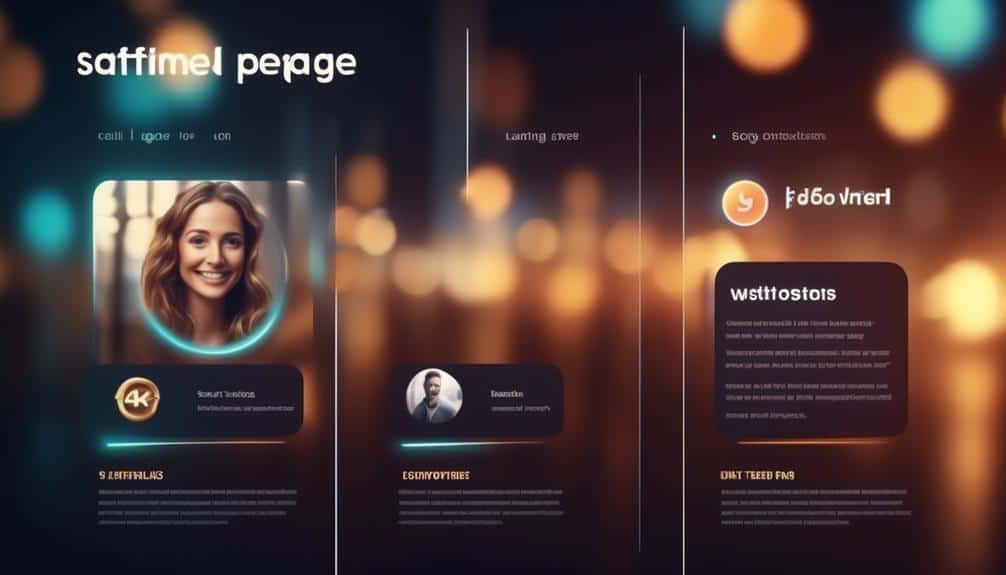Landing Page Legends: Designing Blog Pages That Convert
In the fast-paced world of digital marketing, it's essential to keep up with the ever-evolving landscape of online consumer behavior.
When it comes to your blog, you might have a treasure trove of valuable content waiting to be discovered, but are your landing pages truly doing justice to your hard work?
Crafting a design that not only captures attention but also converts visitors into loyal readers and customers is a delicate art.
As you navigate the realm of landing page optimization, unlocking the secrets to boosting your conversion rates can make all the difference in achieving your business goals.
Key Takeaways
- Utilizing captivating images and color psychology can enhance user engagement and conversions.
- Mobile optimization and fast loading times are crucial for seamless user experience and higher conversion rates.
- Providing valuable, relevant content that resonates with the audience is essential for driving conversions.
- Regularly analyzing metrics and utilizing conversion tracking tools like Google Analytics are key for optimizing blog pages for maximum impact.
Importance of Visual Elements

Incorporating captivating visual elements into your blog pages can significantly enhance user engagement and increase conversion rates. Utilizing color psychology strategically can evoke specific emotions in your audience, influencing their actions on your site. For example, using warm colors like red or orange can create a sense of urgency, prompting visitors to act quickly. Conversely, cool colors such as blue or green can promote feelings of trust and relaxation, ideal for building long-term relationships with your audience.
Image optimization is another crucial aspect to consider when enhancing the visual appeal of your blog pages. By ensuring that your images are high-quality, properly sized, and compressed for web use, you can improve loading times and overall user experience. Studies show that pages with optimized images tend to have lower bounce rates and higher conversion rates, as users are more likely to engage with visually appealing content.
Crafting Compelling Headlines
Enhancing user engagement and conversion rates on your blog pages starts with crafting compelling headlines that grab attention and drive action. The key to a successful headline lies in its ability to evoke an emotional appeal while being optimized for SEO. Research shows that headlines containing emotional triggers like curiosity, urgency, or excitement tend to perform better in terms of click-through rates and reader engagement. By incorporating power words that resonate with your audience's emotions, you can create headlines that compel them to take action.
Furthermore, for your headlines to be effective in driving traffic to your blog, they must also be optimized for SEO. Utilizing relevant keywords and phrases strategically within your headlines can significantly improve your blog's visibility in search engine results. Balancing emotional appeal with SEO optimization is crucial for ensuring that your headlines not only capture attention but also rank well in search engines, ultimately leading to increased traffic and conversions.
Call-to-Action Strategies

Crafting effective call-to-action strategies can significantly boost user engagement and conversion rates on your blog pages. To optimize your call-to-action for maximum impact, consider the following strategies:
- Button Placement
- Place your call-to-action buttons strategically within your content to ensure they're easily visible and accessible to visitors.
- Utilize heatmaps and user behavior data to identify the most effective placement for your buttons.
- Color Psychology
- Choose button colors that stand out from the rest of your page design to draw attention to your call-to-action.
- Experiment with different color schemes to determine which combinations resonate best with your audience.
- Copywriting Techniques
- Craft compelling and action-oriented copy that clearly communicates the value proposition of clicking the button.
- Use persuasive language that taps into the psychology of your audience to encourage them to take the desired action.
Optimizing for Mobile Users
Optimizing your blog pages for mobile users is crucial in today's digital landscape to ensure seamless user experience and higher conversion rates. Mobile responsiveness isn't just a buzzword; it's a necessity. Studies show that 57% of internet users say they won't recommend a business with a poorly designed mobile site. With more people browsing on smartphones and tablets than ever before, your blog must adapt to different screen sizes and resolutions for a stellar user experience.
User experience (UX) is paramount when it comes to mobile optimization. Simplify navigation, use clear fonts, and ensure fast loading times to keep visitors engaged. According to Google, 53% of mobile users abandon sites that take longer than three seconds to load. A user-friendly interface can significantly impact your conversion rates.
Investing in mobile responsiveness isn't just about meeting current standards; it's about exceeding them. By prioritizing user experience on mobile devices, you not only improve visitor satisfaction but also increase the likelihood of turning those visitors into loyal readers or customers.
Utilizing Social Proof

To boost your blog's credibility and influence potential readers, leverage social proof effectively. Social proof is a powerful tool that can significantly impact the success of your blog pages. Here's how you can make the most of it:
- Testimonials Showcase:
- Incorporate testimonials from satisfied readers or clients to showcase positive experiences and build trust with new visitors.
- Utilize case studies or success stories to provide concrete examples of the benefits your blog offers.
- Trust Indicators:
- Display the number of social media shares or likes your posts have received to demonstrate popularity and engagement.
- Highlight any awards or recognition your blog has garnered to establish authority and credibility within your niche.
A/B Testing Techniques
After leveraging social proof effectively to boost your blog's credibility and influence potential readers, the next step is implementing A/B Testing Techniques to optimize your conversion rates efficiently. A/B testing, also known as split testing, involves comparing two versions of a webpage to determine which one performs better. By analyzing user behavior and preferences, you can enhance the user experience and drive conversion optimization.
To conduct A/B tests effectively, start by identifying elements on your blog page that may impact user engagement, such as headlines, images, call-to-action buttons, or layout design. Create variations for these elements and randomly show each version to different users. Analyze the results based on metrics like click-through rates, bounce rates, and conversion rates to determine which version resonates best with your audience.
Continuous A/B testing allows you to make data-driven decisions, refine your blog page, and ultimately improve user experience while maximizing conversion rates. Remember, the key to successful A/B testing lies in testing one element at a time and using the insights gained to iterate and optimize further.
Minimizing Load Times

Enhance your blog's performance by reducing load times to improve user experience and boost conversion rates efficiently. To achieve this, focus on load time optimization strategies that can significantly impact your website's effectiveness.
Here are some key techniques to consider:
- Optimize Image Sizes: Compress images to reduce their file size, ensuring faster loading without compromising quality.
- Minimize HTTP Requests: Combine CSS and JavaScript files, reduce redirects, and leverage browser caching to decrease the number of HTTP requests made.
- Enable GZIP Compression: Compress your website files before sending them to the browser, reducing the amount of data transferred and speeding up load times.
Analyzing Conversion Metrics
To optimize your blog's performance, you must delve into conversion rate analysis and employ effective metrics evaluation techniques.
By analyzing key metrics, you can gain valuable insights into user behavior and make informed decisions to enhance your conversion rates.
Understanding these metrics will enable you to refine your blog pages for maximum impact and drive successful conversions.
Conversion Rate Analysis
Analyzing conversion metrics is crucial for optimizing blog pages to drive desired actions from visitors. To enhance your blog's conversion rate, consider the following:
- Content Quality: Ensure your blog provides valuable, engaging content that resonates with your audience's needs and interests.
- User Experience: Focus on creating a seamless and intuitive user experience by optimizing page load times, simplifying navigation, and making calls-to-action clear and compelling.
- Data Analysis: Utilize analytics tools to track user behavior, identify high-performing content, and pinpoint areas for improvement, enabling data-driven decisions to enhance conversion rates.
Metrics Evaluation Techniques
By consistently monitoring and evaluating key metrics, you can uncover valuable insights to optimize your blog's conversion rates effectively. Tracking performance metrics such as bounce rate, average session duration, and conversion funnels can provide you with a comprehensive understanding of how visitors interact with your blog.
These metrics offer crucial data points to identify areas for improvement and gauge the effectiveness of your content. Additionally, measuring success through conversion tracking tools like Google Analytics allows you to track specific goals and conversions, giving you a clear picture of your blog's performance.
Frequently Asked Questions
How Can I Effectively Incorporate Storytelling Into My Blog Page Design to Improve Conversion Rates?
To boost conversion rates on your blog page, leverage storytelling techniques and engagement strategies. Implement visual storytelling for an immersive experience. Craft compelling narratives that resonate with your audience, driving them to take action.
What Are Some Creative Ways to Integrate Interactive Elements Into Blog Pages to Engage Visitors?
To boost engagement on your blog, consider gamifying interactions with interactive widgets. These elements can captivate visitors, making your content more memorable and encouraging them to explore further. Enhance user experience and drive conversions.
How Can I Use Color Psychology to Influence User Behavior on My Blog Page?
Utilize color psychology strategically to evoke desired emotional responses from users. Establish color harmony for a visually appealing blog page. Implement a strong visual hierarchy to guide users' attention and enhance engagement with your content.
Are There Any Specific Font Choices That Can Help Enhance the Readability and Appeal of My Blog Page?
Choosing the right typography choices for your blog can significantly impact legibility and appeal. Utilize font pairing to enhance aesthetics and readability. Experiment with different styles to find what resonates best with your audience.
How Can I Leverage User-Generated Content to Build Credibility and Trust on My Blog Page?
To influence decisions and build trust, leverage user-generated content like testimonials and user reviews on your blog page. Authentic feedback from others can boost credibility and establish trust, showcasing real experiences that resonate with your audience.
Conclusion
In conclusion, by implementing the following strategies:
- Visually appealing elements
- Captivating headlines
- Effective call-to-action strategies
- Mobile optimization
- Social proof
- A/B testing
- Fast load times
- Analyzing conversion metrics
you can design blog pages that convert at a higher rate.
Don't underestimate the power of a well-crafted landing page – it can make all the difference in turning visitors into loyal readers or customers.
Keep refining and testing your approach to continuously improve your conversion rates.








